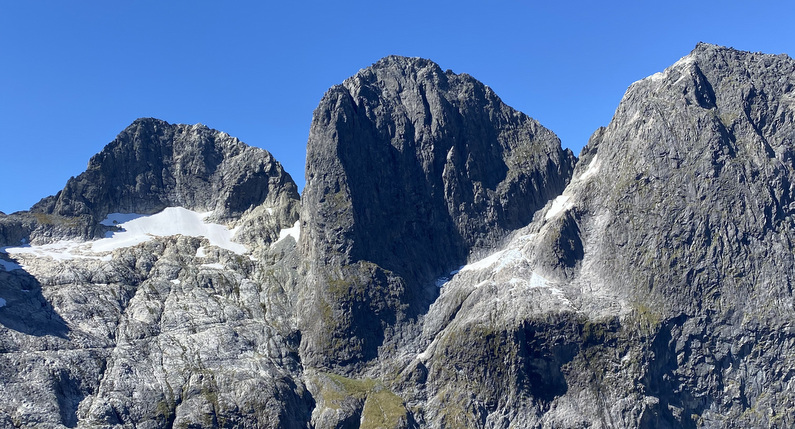
SAR insights: Stranded on Sabre
Sabre Peak is a classic alpine rock-climbing objective, located among the sheer diorite walls of the Darran Mountains in Fiordland. In February 2022, a pair of climbers had summited, but as they began to abseil down, their rope became stuck, stranding them on a small ledge.
The following morning, the climbers activated their Satellite Emergency Notification Device, and the Rescue Coordination Centre New Zealand tasked the Wakatipu Alpine Cliff Rescue (ACR) Team and Southern Lakes Helicopters to respond.
It was a clear day, but quite windy. As the rescuers flew a recon-naissance, they realised the climbers weren’t attached to the mountain. This presented a real risk of the climbers being affected by the com-bined wind and helicopter down-wash. Landing in the basin below, the team formulated their plans and prepared for the operation. Jono Gillan was the ACR team leader that day. “This was my first operation back as a volunteer, after time spent in a role with the Aoraki Mount Cook Alpine Rescue Team (AMCART),” says Jono. This situation had many similarities to the operations around Aoraki, using a helicopter and longline to rescue people from a sheer cliff with more than 500m of exposure below, so he was able to apply his experience on that windy day.
Using a 200-foot long-line to maintain separation from the cliff and reduce down-draft on the climbers, Jono was flown directly to their small ledge. Initially building an anchor to connect everyone to the mountain, he coordinated the rescue as each climber was recovered by an ACR member, using a tethered belay technique. “When using this technique, the personnel are briefly attached to both the helicopter’s longline and the mountain.” Jono continues to explain; “During that short moment of transition, if the helicopter can’t maintain its position, the belayer needs to release them immediately from the mountain to prevent a catastrophe.”
Five hours after the responders were tasked, both climbers were rescued and all the ACR personnel were off the mountain. After the operation, members of AMCART were invited down to Queenstown to conduct some mutual training on these complex techniques. “Using a helicopter in an alpine rescue is an extremely high-risk operation,” says Jono. “Post-COVID, the ACR teams around Wānaka and Queenstown have been doing more operations similar to those at Aoraki. Spending the time to train together helps ensure our capability is maintained and standardised across the board.”
It also helps the subject matter experts keep up with new tech-niques and equipment. “The Europeans are among the busiest alpine rescuers in the world. They’ve developed specialist hardware such as the PETZL Lezard, which performs the function of a tethered belay [as used in this rescue on Sabre Peak]. Collaboration gives us the chance to discuss these innovations, and begin the proper process to consider them for use in New Zealand SAR work.”
“We’re also grateful to the helicopter operators who’ve been really supportive of more training and collaboration, particularly in winch-ing and long-line techniques. Standardisation across all teams and agencies means together, we have more flexibility to respond to alpine incidents, with a greater margin of safety.”
Insight summaries
- Collaborative training between groups and agencies promotes standardisation.
- Standardisation improves flexibility, efficiency and safety.
- Regular contact through collaboration keeps personnel in touch with innovations which could improve SAR outcomes.
This article was first published in the September 2023 issue of Link magazine.
Feature image: Sabre Peak. Courtesy Jono Gillan
